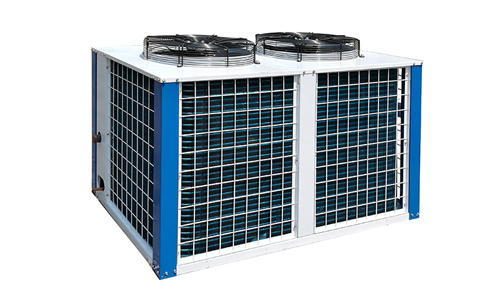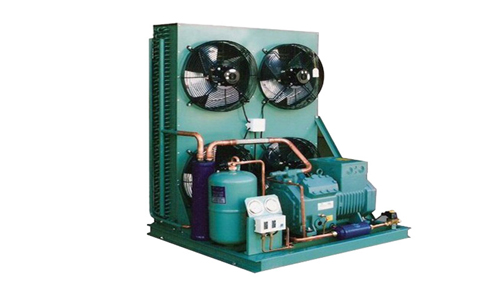TYPES OF CONDENSERS
The function of a condenser is to allow high-pressure and high-temperature refrigerant vapor to condense and expel heat. There are three main types of condensers: air-cooled, evaporative, and water-cooled condensers. Manufactured from imported parts, our Two-Stage Air Cooled Piston Condensing Unit ensures maximum output and acquires less space to meet the latest standards.
Air-cooled condensers
Air-cooled condensers usually consist of tubes with fins, but occasionally there are wires or even plates fixed to the refrigerant tubes. These give the condenser a larger surface area and allow for more efficient cooling. Air circulation is achieved by static means, where the air in contact with the ducts becomes hot and rises to be replaced by cooler air. Or, more typically, there is forced convection, where a fan moves air through the condenser.
Condenser fins need to be kept clean to maximize heat transfer and cooling to the refrigerant. Having Bitzer's two-stage semi-hermetic compressor, our piston condensing unit is highly reliable and of good quality. The condenser in the two-stage water-cooled piston condensing unit increases the ratio of energy efficiency and cooling capacity.
Air-Cooled Compressor Unit
Water-cooled condensers
Water-cooled condensers typically consist of an outer tube carrying hot vaporized refrigerant that flows through an inner tube containing counter-flowing cold water. These shell and tube condensers are very efficient. Water-cooled condensers are more complex than air-cooled condensers because of design considerations in water flow regulation and corrosion protection. However, the advantage of water-cooled systems is that the water has a higher exchange coefficient than air, resulting in more efficient heat transfer.
Evaporative condensers
In large systems, evaporative condensers are used to combine airflow with water. The refrigerant is condensed by using a combination of airflow and water sprayed onto a coil (usually in a tower). The water is then collected in a tank and pumped back to the sprayer. Forced ventilation is used to force the air upward through the tower.
Care needs to be taken with this type of system to ensure the cleanliness of the water.
Condenser
The function of a condenser in a refrigeration system is to transfer heat from the refrigerant to another medium, such as air and/or water. By discharging heat, the gaseous refrigerant condenses into a liquid in the condenser.
The three common types of water-cooled condensers are (1) double-tube condensers, (2) shell-and-tube condensers, and (3) shell-and-coil condensers.
Two-Stage Air Cooled Piston Condensing Unit
In a two-tube condenser, water is pumped into the inner tube and refrigerant flows into the outer tube. Counter-flow is maintained to obtain high heat transfer efficiency. Although double tube condensers were commonly used in the past, the large number of gaskets and flanges used in these heat exchangers led to maintenance problems.
In shell and tube condensers, water is pumped through the tubes as the refrigerant flows through the shell. Fitting fins in the tubes allows for better heat transfer. Shell and tube condensers are usually low-cost and easy to maintain. In a shell and tube condenser, the welded shell contains a ring of finned water tubes. It is usually the most compact and least expensive.
Air-cooled condensers can be tube and fin or plate types. The fins on the tubes provide a large heat transfer area in a compact shell. Plate condensers do not have fins, so they require a considerable surface area. However, they are much cheaper to build and require little maintenance. Both types of condensers can be found in domestic refrigerators.
Air-cooled condensers can also be used to move air manually by using a fan. Fans help to obtain a higher convective heat transfer coefficient on the condenser surface. In evaporative condensers, a circulating pump draws water from a pan at the bottom of the condenser and sprays it onto the coil. In addition, a large amount of air is drawn into the condenser coil. The evaporation of water requires latent heat extracted from the refrigerant.
The source is from here.
The cold storge also can use for meat,potato,vegetables.



评论
发表评论